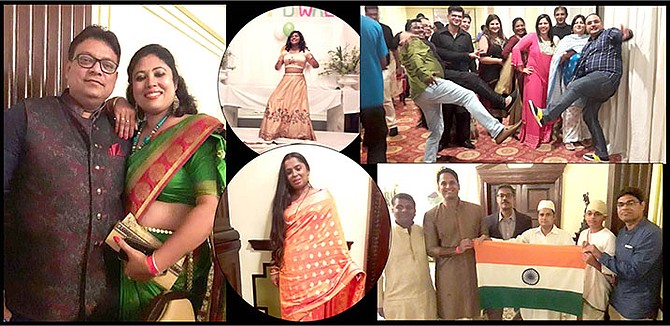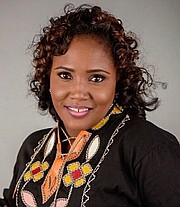Diwali symbolises the spiritual victory of light over darkness, good over evil and knowledge over ignorance.
By FELICITY DARVILLE
This week’s focus is not on an individual, but a group of people and what they taught me about humanity.
I have always been an open-minded person. I embrace many religions and cultures. I respect them and I learn from them. I hold on to the things that suit my perspective and I let go of things that do not. I am not held up on dogmas and conditioning handed down to me. I see the universal truth and the need for universal love to heal the ills of humanity.
So it was with open arms that I embraced an invitation to attend Diwali celebrations with the Indian community in The Bahamas for the fourth year. Dr Murthi Gali, an association member, keeps in contact with me and would call me when something pops up in his mind that he thinks I have the answer to, or sometimes just to say hello. The opportunity he has allowed me to interact with a vibrant community who not only love their Indian culture, but they love The Bahamas. “I am Bahamian! I was born here!” said one Indian I spoke with on the night we celebrated Diwali.
Diwali is a festival of lights and is one of the most popular festivals of Hinduism. Nearly 80 percent of Indians identify as Hindu. Diwali symbolises the spiritual “victory of light over darkness, good over evil and knowledge over ignorance”. In the lead-up to Diwali, celebrants will prepare by cleaning, renovating and decorating their homes and workplaces. During the climax, revellers adorn themselves in the finest clothes, illuminate the interior and exterior of their homes with oil lamps or candles, light fireworks and prepare feasts.
Here in Nassau, Diwali celebrations took place at Breezes resort. First, participants took their lamplights out to the beach in a beautiful display, followed by fireworks. Events then moved to the ballroom and included a full cultural show followed by a wonderful buffet filled with traditional Indian dishes.
The Bhagavad Gita discourse presented by a young boy resulted in a standing ovation and loud cheers from the crowd. Although quite young, Sohan Gowda memorised his part – an extensive explanation about what the Gita is, its significance in Hindu culture, how it is set up, and understanding the mythical stories entailed. He explained that Bhagavad Gita means “song of God”. He told us that this ancient manuscript came about some 5,000 years ago. He shared several moral lessons to take away from the manuscript. He executed his delivery without a mistake and used inflections and hand gestures, much to the delight of the crowd.
The children really stole the show with a series of entertaining and thoughtful performances. They included a boys group dance and a girls group dance, choreographed by Bindu Biswal. Vik and Ashok Nair performed a melodic flute duet. Akhilan Subramaniam and Jiya Kotai performed solo dances; and Navaneet Biswal and Varchas Yadav performed a duet dance. Each of these performances were unique and different and highlighted the beauty of Indian music, fashion and other cultural expressions.
The comedy performance by 11-year-old Navaneet Biswal on the ‘Nagging Indian Mother’ was hilarious, while the skit by team ICB was thoughtful and provoking.
The cultural performances were preceded by a light buffet of samosas, one of my favourite things to eat, as well as shrimp and vegetable spring rolls and pakora, which is battered and fried greens. The performances were followed by the feast buffet. It included West Indian pumkin soup with roti, paneer butter masala, tadka dal, vegetable biriyani, chicken tikka masala, butter chicken, lamb biriyani and an assortment of Indian sweets.
The outfits worn by the men, women and children were outstanding. Beautiful colours and fabrics and bright jewellery were accentuated by friendly smiles. Similar to a Christmas celebration, all night you could hear: “Happy Diwali!”.
The great relationship between India and The Bahamas was underscored by High Commissioner Sevala Naik when he attended last year. His office is stationed in Jamaica, but he serves The Bahamas and the region, and I am told by Dr Gali that he visited The Bahamas earlier in the year. Since his credentials were presented to The Bahamas government in January 2017, Naik said he has been “touched by the warmth of the Bahamian people”.
“We greatly enjoy the beauty of the city Nassau including its clean beaches,” he said. “India and Bahamas have traditionally enjoyed very cordial and friendly relations, which are based on historical Commonwealth linkages and strong democratic traditions. Both countries have convergence of views on various important contemporary issues, shared concerns, aspirations, and excellent cooperation at various multilateral fora.”
“I would like to place on record our deep gratitude and appreciation to the Government of The Bahamas particularly senior officials of the Ministry of Foreign Affairs for extending visa on arrival for Indians travelling to the Commonwealth of The Bahamas. This liberal visa regime will boost visits from the Indian community for tourism, destination weddings and many other events. I am sure these trends are just beginning and will multiply in the days to come.”
He commended the Indians who live here, many of whom are “vibrant professionals”, including doctors and businessmen. I attended St Augustine’s with a few students of Indian descent with whom I became friends, including Smirti Sharma, Simma Jagadeesh, Shilpa Shartia and Puja Bhatnagar. Their parents were always supportive and pushing them to do their very best. Like Navaneet said in his comedy, if your GPA is not up to standard in an Indian home (meaning better than their friends or other family members’ children, “their life is over”. It was a funny play on the importance that Indian families are known for putting on education. It has paid off well as Indians notoriously contribute well to fields such as medicine and engineering.
“Today with a population of 1.25 billion, over 1 billion mobile phone connections and over 1 billion biometric based National Identification cards (Aadhaar), India is witnessing rapid economic and social changes,” High Commissioner Naik told me.
“The country is going through a big transformation. The Indian government envisions transforming India into a “New India” — a strong, secure and prosperous nation where everyone has access to opportunities of development. In order to have these changes sustainable, India’s government launched four flagship programmes namely Digital India, Make in India, Clean India and Skill India and these are creating a renewed thrust on the domestic market.”






Comments
Use the comment form below to begin a discussion about this content.
Sign in to comment
Or login with:
OpenID